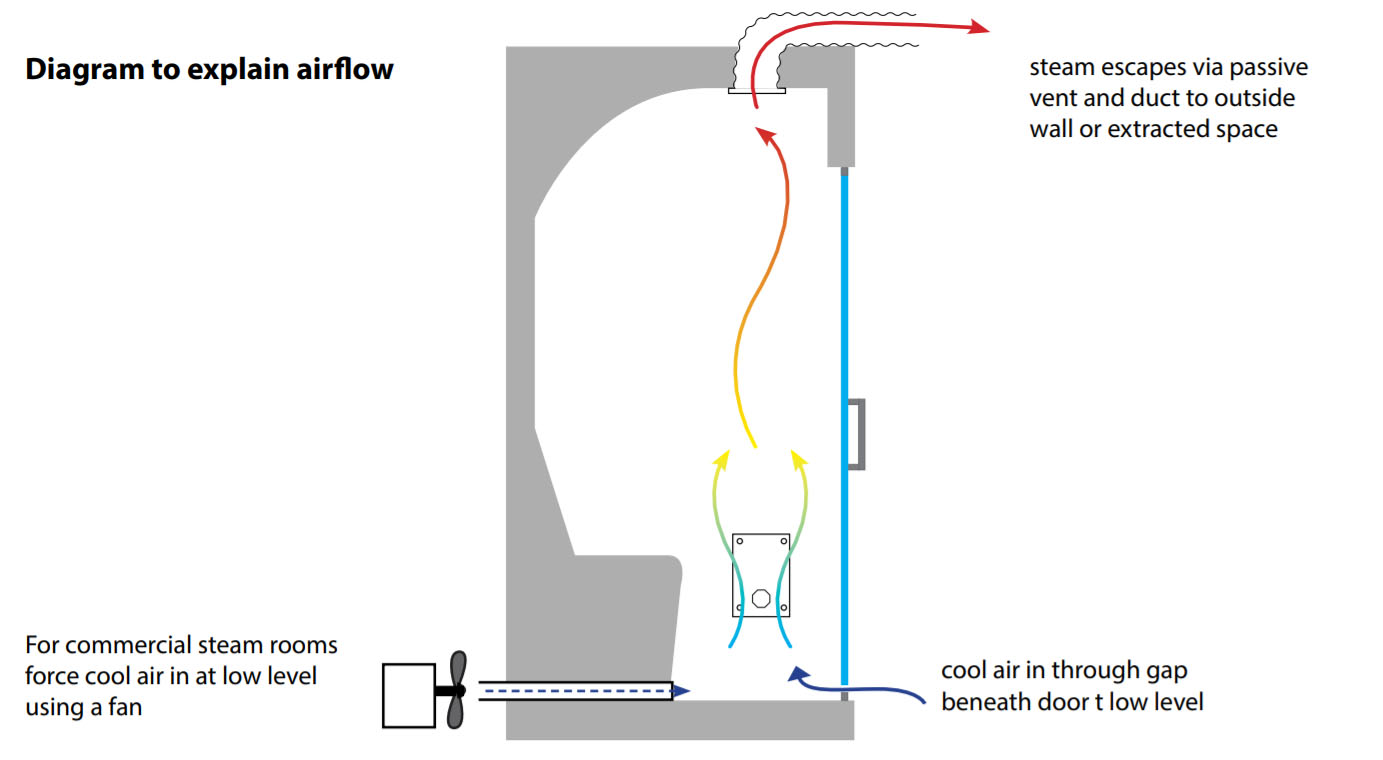Guide to Building a Steam Room
Structure
The structure can be built from block work or timber.
Insulation
Never tile directly onto block work, always insulate block work. We advise using a foam cement board. For domestic purposes 20mm of insulation is sufficient.For commercial we advise going upto 70mm or more if possible. This will reduce the running costs but will require good ventilation and airflow.
Ventilation
Good airflow is crucial to maintaining fresh steam.
With a well insulated room once the steam room has reached the temperature set on the control the heating elements in the generator will switch off and only come on again once the temperature drops sufficiently. The dew point of the room will also change when the walls and air heat up causing the steam to turn clear rather than white. The room is still at 100% humidity but the vapour has now dissipated. Similar to when breathing in the summer compared to the winter. Cool air flow will prevent the generator from switching off for long periods and create nice fresh white steam inside the room.
For domestic purposes this can be achieved by just using a static 4” vent (no fan), the duct can either run into a wet room such as a pool hall or bathroom which should have it’s own forced extraction(with fan) or run directly outside.
For commercial purposes you should install a variable speed fan blowing into the room at low level, you should then have a static vent running to outside at high level, this can be to a wet area but this area must have a powerful extraction system in place.

Substrate (boards)
Use a foam cement board preferably one with a vapour barrier. For rooms that are used for longer than 2 hours ie commercially it is imperative that you use a board with a vapour barrier. Good quality vapour barriers can be difficult and expensive to source so purchasing a full Oceanic steam room is recommended.
Tanking
Once all the boards have been fixed you should tank the room at least 3 times to give a water tight room.
Tiles
We advise to not use any thicker than 10mm tiles. The thinner the better, if you are looking for a quick heat up time the thin tiles will obviously heat up the quickest, this also means you can use a smaller generator especially if you have insulated the room.
Lighting
The steam within the room can be illuminated to create soft ambient glow. There are various fittings that can be used to create atmospheric lighting effects. Linear LED strips, fibre optic star ceilings, recessed colour change LED sources beneath benches or in the ceiling. All fittings should be rated to at least IP65 and resistant to oxidation as steam is aggressive at oxidizing metal. Chromed plastic is a better option than metallic luminaires.
Keypad
For domestic purposes you can locate the keypad inside or outside of the room. Obivously by putting it inside you can adjust the settings while in the room, but we find that once you’ve found what temperature works for you
then you don’t touch the settings again as the keypad remembers the last setting for time and temperature so you just push the on button before you want to use the room.
Choosing The Correct Size Steam Generator
Multiply your dimensions to find the volume of the room L x W x H = m3
Remove the volume taken up by the benches.
Then use this equation 1m3 = 1kw
If you have not insulated the room as explained above you should use the following:
+ 0% plastic
+ 20% for ceramic and porcelain
+ 100% for marble and granite (upto 30mm thick)
If you do insulate the room and you use thick marble or granite you should add 20% but bare in mind the heat up time may be between 30-90 minutes.
Steam Outlet Location
Steam Outlet is located 300mm above the floor. It is important position the steam outlet as far from a users feet as possible. For domestic purposes you don’t have to have the steam nozzle guard as they can become quite obstructive in small steam room but you must make any user aware of where the outlet is before using the room.
For commercial purposed the steam outlet should also be as far from the user as possible with a guard and also signage telling the users that the outlet is hot and not to touch it.
Heat up time and cost
If you have built the room as described and used the correct size generator then the room should reach temperature within 20-40 minutes depending on the ambient room temperature (ie it may take longer during the winter)
1kw is around 13 pence and we say for 2 hours the generator will be working 60% so this would be 13 x 2 x 0.6 = 15p for two hours for each kw. So if you had a 6kw generator for a two hour session you may spend around £0.90


